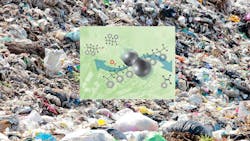A New Way to Break Down Polystyrene and Clean up the Environment
Scientists at the U.S. Department of Energy’s Ames Laboratory, along with partners from Clemson University, have discovered a low-energy process that breaks down polystyrene, a plastic widely used in packaging materials, disposable food containers and cutlery, and many other applications.
Hundreds of millions of tons of polystyrene are produced annually, most of which for products that are discarded after a single use. While polystyrene’s chemical stability and durability make it well suited for those products, it prevents the material from biodegrading or breaking down, even in landfills. As a result, tons of the used plastic get burned, creating carbon dioxide and other hazardous gases.
To compound the problem of polystyrene, recycling it is not economically feasible. It takes too much time and money to sort and separate the used plastic from the waste stream, and then chemically breaking it down consumes too much energy and involves toxic solvents. To add insult to injury, styrene recycled this way is often inferior to virgin polystyrene.
The research team at Ames Laboratory used ball-milling, a form of mechanochemistry, to recycle commercial polystyrene in a single room-temperature/ambient-atmosphere step that does not rely on harmful solvents. In ball-milling, materials are placed in a milling vial along with metal ball bearings, and then the vial is shaken until a desired chemical reaction occurs. This experimental approach has many applications in new materials synthesis and attractive features for plastics recycling, according to the team.
Ball-milling breaks down polystyrene through a series of chemical events which mechanically cuts apart the macromolecules. This generates free radicals which are detectable in the milled material even after prolonged exposure to air. The metal bearings used for milling, together with ambient oxygen, act as co-catalysts that enable extraction of the monomeric styrene from the oligomeric radical-bearing species formed. Experiments showed that the temperature increase in the material during milling is not responsible for this phenomenon since the temperature is below 50oC polystyrene does not thermally decompose in air unless the temperatures over 325oC.
The Clemson’s group confirmed that the resulting fragments (oligomeric materials), can be processed into new plastics for making new products.
